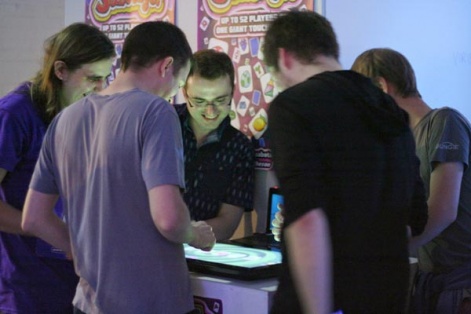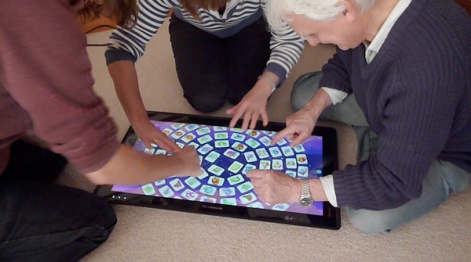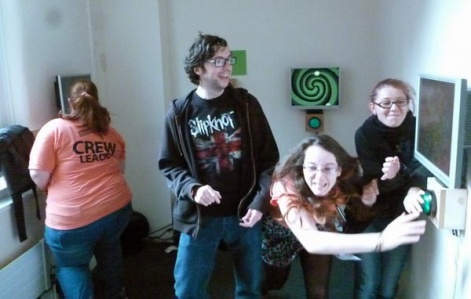Alistair Aitcheson is the indie developer of such as games as Greedy Bankers and Slamjet Stadium.
Earlier this year I launched Tap Happy Sabotage - a party game designed for big touchable screens.
Up to 52 players can gather around one device and are encouraged to get into each other's way, grab at each other's arms, and generally play dirty.
Since its launch, I've taken it to Gamescom 2014, as part of the Unity exhibit, demoed it to families at Bletchley Park, had it selected for the EGX Leftfield Collection, and even turned it into a room-filling installation for GameCity Nottingham.
Everywhere I take the game I get the same enthusiastic response: "This game is crazy", "chaotic", "absolute havoc".
Players love craziness. Craziness keeps players alert. Craziness gets players excitable, and excitable players socialise more.

But what are the elements that create that craziness? How can we design havoc without it being confusing, overwhelming or arbitrary?
It starts with surprise
Surprise is a powerful motivator.
Suspense is an amazing motivator but it comes with a caveat.Alistair Aitcheson
Give players something they weren't expecting, make them do something they weren't prepared for, and they'll be alert and excited about what more is to come.
But surprise cannot exist on its own. Peaks need troughs, and good troughs are not about being slow, or low on activity, but about being familiar.
Tap Happy Sabotage tasks you with finding the picture card assigned to your player, and tapping it before your opponents do. Each round lasts roughly 2 minutes, and each new round changes the rules.
For example, you may have to drag your card away from a bomb or hold down three of your card at once.

Early versions introduced new rules randomly each round. But having to learn one new rule when you've only just got used to the previous one got players confused. In the released game, every odd-numbered round is the same: "find your card."
If the previous round had them shaken, the familiar grounding of "Find your card" gave players a chance to succeed at something they already knew how to do. It also cemented surprise rules as being variations on the regular rules, making them easier to decipher.
In the GameCity installation, which used big bashable wall-mounted buttons, there was another clear differentiator between rounds. Half were based on observation, and half were based on reactions.

If all the rounds were based on observation the pace would have been slow. If all the rounds were based on reactions players would have tired out. With both types, players need to find short bursts of energy for a couple of minutes, then engage their visual reasoning for a couple of minutes.
Neither skillset outstays its welcome, and having to change mindsets is stimulating for the player.
Suspense
One very popular round at GameCity showed just one card per screen. Most of the time, none of the cards belonged to a player. No players could score. Then the cards would swap out, and be replaced with more cards… belonging to none of the players.
But every so often, when the cards swapped out, every player's card would appear at once.
Bam! Everyone dashes to their button at the same time.
Suspense is an amazing motivator but it comes with a caveat. For players to enjoy waiting on tenterhooks, they need to understand what they're waiting for.

This round would have made no sense to players if they hadn't played the basic "Find your card" round first.
The round was introduced with the words "Find your card when it appears" so that players didn't get confused when their cards didn't show up.
Disguising objectives
One of my favourite strategies with games like this is to use misleading objectives. So, for example, when players are told "Don't tap your card!" the game actually means "Tap your opponents' cards!"
This allows players to have an "aha!" moment, realising they can twist the rules to their advantage. It also gives players an empowering sense of rule-breaking: the game told them to do something, they did something else, and they won!
For this trick to work, your choice of vocabulary is hugely important.
Clarity has to take precedent. Without it the game loses momentum.Alistair Aitcheson
When I adapted this round for the GameCity installation, I had to change the wording of the rule when it came on screen. Originally it read "Don't bash your card." Players needed to work out that bashing a card meant hitting the big button next to it, and then work out that they should go for everyone else's cards. There were too many steps and it killed the pacing.
I changed the wording to "Bash to eliminate," but in removing one ambiguity I'd gone and created another: "eliminate what from what?"
The eventual round description was simply "Bash your opponents' cards," losing a little of the mischief but keeping the clarity. Clarity has to take precedent. Without it the game loses momentum.
Conclusion
Great party games centre around creating memorable situations between friends. Using simple rules helps get large groups involved. Unambiguous communication from the game means players spend less time working out what to do and more time interacting with each other.
The developer needs to be aware, at all times, of what players think is going on.
How well can they understand the current objectives given their understanding of the previous ones? Is there a conflict between what the game tells them to do and they want to do? Can they be surprised if they have no sense of what "normal" is supposed to be?
If you can see the gameplay from players' eyes then you know what they're expecting. When you know what they're expecting you can twist that.
If you twist those expectations just when the game's started to feel familiar, then you get craziness that players can sink their teeth into.
Full Indie UK is a friendly group of UK Indie Game Developers who have teamed up to become friends, help each other out, and make great games.
We’re always looking for new members, so please visit our website to join.






















